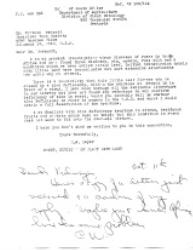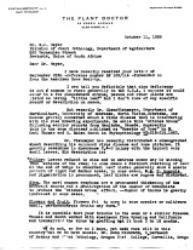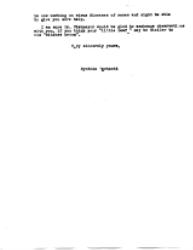Next Page
Part 1 - RRD may NOT be Native to North America
Part 2 - The Ross Rambler Rose
Part 3 - Original Source Material
Part 4 - RRD in South Africa?
Part 5 - RRD in Czechoslovakia or recently in Poland?
Part 6 - Did Redoute' Paint a Picture of RRD 120 Years Before It Was Discovered?
Discussion of a disease that has not been isolated is difficult; comparison with disease outbreaks
reported from decades past is also problematic. Nonetheless, in the last century there were rose diseases that shared symptoms with Rose Rosette; these diseases disappeared from roses and are only recorded in scientific literature in musty shelves of libraries. Reading about plant viruses shows that some symptoms are common, even though the viruses are different and the affected plants may not be closely related. Epinastic leaf distortion happens, as do parthenocarpic hips and mottle and mosaic patterns on leaves, to name a few.
What unites the reports below are the plants involved, roses. There are also symptoms that seem to
recur through time. Only when Rose Rosette Disease is isolated and characterized will we even know if it is, in fact, a virus and if it meets Koch's Postulates and can be called a virus. Only when it is isolated and replicated will we know if the RRD that has been at the center of the Iowa State effort is identical to the RRD of the wild roses of the western USA. Only when it is isolated and replicated will we know if roses such as Rosa setigera that appear to be immune to RRD infection are truly immune or if they are asymptomatic or resistant.
Part 1 - RRD may NOT be Native to North America
by Larry Peck 5 Oct 2001
Introduction: The view expressed here, that RRD may not be native to North America, is a minority
view. Most scientists believe Rose Rosette is native to North America. They have read it many times,
although little evidence has ever been presented and most people have never looked into the matter first hand. The history of RRD is, at best, murky (see Chapter 6). This hypothesis suggests an alternative
origin.
Fact: The first mention in scientific literature of "Witches' Broom of Roses", what we now call Rose Rosette Disease (RRD), was at the Morden Experimental Farm in Manitoba, Canada in 1940 (Conners, 1941). The first rose in the US diagnosed with it was 'R. rubrifolia' at the State Training School in Lander Wyoming in 1941(Thomas & Scott, 1953). These two sightings plus one in Trinity Co. CA on a wild 'R. pisocarpa' "about the same time" and an additional outbreak at North Platte Nebraska in 1956-59 have been cited as evidence that RRD is indigenous to much of North America (Viehmeyer 1961). This interpretation seems to have been accepted without question. “Endemic” as used by Mr. Viehmeyer implied it is indigenous - native to North America, and it's status as an "All-American Malady of Roses" (Epstein, 1992) is one reason it has been touted as a biological weed control. I have great respect for Mr. Viehmeyer and have gone back to his original papers. His view formulated in 1961 is perfectly understandable, but we have the advantage of forty years of hind site.
Opinion: The interpretation that RRD is an "all-American Malady of roses" is doubtful for several reasons. First, the timing of the first three sightings, at about the same time, is too coincidental. Had it been endemic to large areas of the West and Midwest, the sightings should have built up over time - decades or even a century. The timing of these three sightings suggests it came to the first three locations through commerce or plant swap and then jumped to other roses, like the wild `R. pisocarpa' in Trinity County California. Infected plants arriving in other areas would simply die, get pulled out and never get reported. Due to the lack of a reservoir population of roses at other locations RRD didn't take hold.
The symptoms of RRD are not unique to roses. Witches' broom like structures are known on many
plants. Changes in blooming character, stems growing in distorted spirals, changes in thorniness- all
would have been noted by early homesteaders who had a more limited number of flowers than we do
today. Early plant explorers could have collected the witches' broom producing roses as the kind of odd form that might appeal to eccentric collectors.
How odd are collectible roses? The so-called 'Celery Rose' was so desirable in the Court of Napoleon, that Redoute painted it. The epinastic leaf form of the Celery Rose implies a virus-like organism of some sort and it was hard to propagate accord to Thorey. In a similar vein, there is a form of Rosa multiflora called R. multiflora watsoniana, which is also called the 'Bamboo Rose' for its extremely narrow leaves. (Our plant also tends to mildew heavily.) It was introduced in 1870 from a Japanese garden when it had been treasured. Sadly, the 'Green Rose', a deformed varient of 'Old Blush' is the largest selling China Rose in the U.S.
We have found no evidence any aberrant roses were collected nor have we heard of any prairie diaries
talking about strange roses. Rose culture in the Midwest and West did not start in 1941. Settlers carried roses with them as they crossed the continent. The spread of 'Harison's Yellow', also called the "Pioneer's Rose", attests to the long history of rose culture in these areas. 'Harison's Yellow' is still found in Nebraska at abandoned pioneer home sites (Dale Lindgren, 2001, pers. com.)
During the 19th century both the US Government and private groups, including museums, sent
expeditions of naturalists and artists into the West to study the area. J. Horace McFarland, the founder of the modern American Rose Society, and John Muir, founder of the Sierra Club, went together on such an expedition in 1902 into the Mountains of California. McFarland recounted the story forty years later at the ARS Convention in Knoxville (1942 American Rose Annual). What are the chances that all the professional naturalists and all the local settlers would have missed seeing Rose Rosette for a century and a half and it would then be found at three different locations at about the same time? This is even more unlikely when you consider that roses in the west are most often found along streams, which is also where the people were and are.
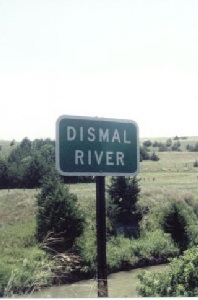
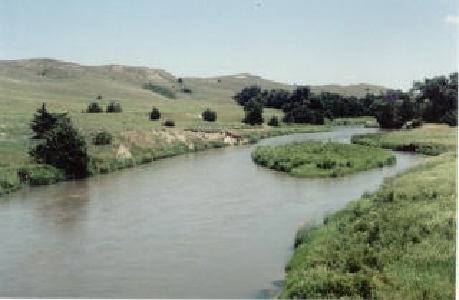
Above: The Dismal River at old US 83 where Viehmeyer and Allington looked for RRD in the wild roses. The rivers
are down in narrow valleys with almost no flood plain. The picture below, taken along US83 between North Platte
and the Dismal River shows what's above the valleys. These are called the "sand hills". Few trees or large woody
shrubs , - just grass, fence posts & power poles. For RRD to spread, it had to have roses and they would have to be
contiguous enough to spread the disease. It would probably have been seen had it been endemic to the area prior to
the 1956-59 outbreak at the North Platte Experiment Station. (The South Platte River Valley is the path of the
Oregon Trail.)
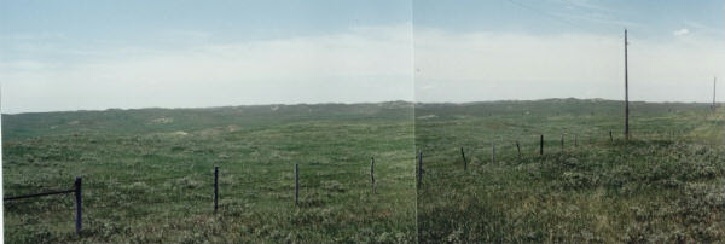
It is true that the increase in the range of `R. multiflora' starting in the 1930's provided a potential host
population to spread RRD, but the first three (now five) sightings of the disease were in areas without
wild multiflora. An additional piece of evidence said to bolster the assumption that RRD is native to
North America is the fact that two of the many native North American rose species, 'R. setigera' and 'R. blanda' are thought to be resistant to RRD. The gapping hole in this argument is shown in the following maps:
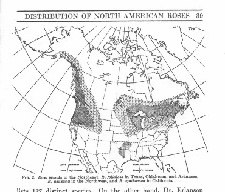
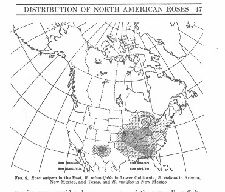
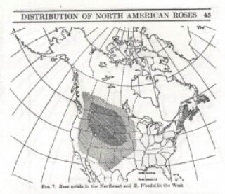
Part of a series of maps from the 1942 ARS Annual showing the distribution of North American species roses. The
map on the left includes the range of R . blanda (the eastern shaded area) and the map on the center shows the
distribution of R. setigera (also the eastern shaded area). Please note that neither range encompassed the presumed
natural range of Rose Rosette Disease (Trinity Co. California to Lander Wyoming to Morden Man.). The extreme
western limit of R. blanda just barely makes it to Morden. The map on the right shows the distribution of R. woodsi,
one of the native roses that now harbor RRD in the wild.
The argument that a natural immunity proves these species roses somehow coexisted with RRD over a long period of time is contradicted by the discontinuity in the range of the two rose species and the
presumed eastern limit on the extent of "Natural" RRD. First, the presumed range of native RRD does not overlap the ranges of R. setigera, one of the "immune" native species. Second, what does this say about all of the other native North American roses that are not immune and whose ranges are within the presumed range of Rose Rosette Disease? It has also been pointed out that R. bracteata, a weed in the deep south, is the only rose species on which the mite vectors of RRD are unable to reproduce (Epstein, 1999), but that species is native to East Asia, not North America. Better evidence of coexistence, rather than immunity, would be a plant's ability to tolerate infection over the long term.
If the disease was not native to North America, then what was its origin? One possibility is that RRD is a virus that jumped species. Another possibility is that it was imported on roses used for a cold hardy rose breeding program. Early occurances of RRD were on roses in such programs. Another possibility is that it was imported by accident on one rose that found its way into the breeding programs.
Speculation: Circumstantial evidence points to a few possible candidates for this. One candidate is the 'Ross Rambler', described in part 2 of this chapter. It came from the Himalayan Mountains of India in the 1920's and was pictured in the 1935 American Rose Annual with glowing comments about its cold hardyness. Percy Wright praised it again in the 1938 ARS Annual. The point was made that this rose survived winter temperatures of - 41 F during the winter of 1932-33, a rose killing winter long remembered. If you loved roses and lived in the mountains of Wyoming or California (the sights of the 1941-42 outbreaks), this would have attracted your attention. With an endorsement by no less than the great rosarian J. Horace McFarland himself, it's possible that at least two people may have imported this rose from Canada into mountainous areas of the United States.
In late June 2001 we went up to North Platte, Nebraska to look at Glenn Viehmeyer's surviving papers
and correspondence. Mr.Viehmeyer was conducting a cold hardy rose breeding program there in the
late 50's and early 60's. He was the first person in the US forced to deal with a large-scale outbreak of
RRD starting in 1956 and culminating in the burning of over an acre of roses in 1959. (One of his
assistants still lives in North Platte and remembers the day the roses were burned.) Mr. Viehmeyer was
a very observant and meticulous person who made great contributions to ornamental horticulture in
Nebraska. He went through great pains to avoid accidental spread of the disease by plant shipment,
sending out only one batch of infected plants (that we know of) to Dr. J.A. Milbrath of Corvallis,
Oregon for a test garden. When approached by someone in 1961 for RRD specimens for use as a weed control, he told them not to do it. Having burned his own ornamental roses, he knew the potential problems and told the person "you may be extremely unpopular with rosarians” if he did it. He retired in 1966 and died in 1974. It's a wonder his files on RRD survived, but they did.
On the way there, we visited with Dr. Stanley Jensen, a USDA virologist who worked on the High
Plains Virus (HPV). He had been a graduate student in the 50's under W.B. Allington - the man who
determined RRD was carried by the eriophyid mite Phyllocoptes fructiphilus and he kindly shared
many insights with us. HPV, like Rose Rosette, is an eriophyid mite born virus. It infects both corn and wheat with symptoms that are in their own way as variable as the RRD symptoms on roses. HPV is one of a group of virus like pathogens (based on size and particle wall structure determined by SEM) that includes Rose Rosette. By isolating the virus, an ELISA test could be performed to test for the presence of HPV in plants, resistant plants could be developed and equally important, cultural protocols were developed to minimize HPV infection and damage. HPV has been found in both symptomatic and asymptomatic plants. He and his coworkers found HPV can be transmitted via seed at a very low rate. The actual rate was 6 seeds out of almost 48,000 planted (Forster, et al, 2001). If we infer that certain characteristics of HPV and RRD are the same, admittedly a risky assumption, a low rate of seed transmission could have important implications for RRD, although seed transmission is not necessary for this hypothesis.
That same week, Ann found a published account of what may be the first case of "Witches Broom"
ever seen in North America - the volunteer rose later named 'Ross Rambler'. The rose, unlike any rose
previously seen in the area, was found growing in a bed of pine seedlings that had been imported from "India", at the Dominion Forest Nursery in Indian Head, Saskatchewan. A cutting from that rose ended up at Morden prior to their 1940 RRD outbreak, and was used in propagation for their cold hardy rose program. The entire article from the 1974 American Rose Annual appears at the end of this one as "Part 2". It is our second piece of historical evidence to support our view that RRD may not be native to North America.
An additional (unreported in scientific literature) early case of RRD appears in the 1946 American Rose Annual in "Progress in Breeding Hardy Roses” by Isabella Preston of the Central Experimental Farm, Ottawa, Canada. The 1946 article told of progress during the war years, the intervening five-year period since her earlier report on “Central Canadian Rose Breeding” in the 1940 Annual. This viral infection occurred at the Central Exp. Farm between 1940 and 1945. One of the plants was the original, by then fully grown, seedling of 'Carmenetta' (R. glauca (ex R. rubrifolia) x R. rugosa). 'Carmenetta', introduced in 1923, was one of the Central Exp. Farms most successful introductions. The article reported, “In recent years it has been attacked by a virus disease and has had to be destroyed.” We know of only one rose virus that would have required that remedy - RRD, especially in the early 40's. We later confirmed this outbreak with the Canadian Plant Disease Survey 1945 (Conners, 1946). There was another (now familiar) rose that appeared at the Central Experiment Farm before the RRD outbreak - the Ross Rambler. Preston (1940, p.92) reported crossing the 'Ross Rambler' with R. rubrifolia at the Central Exp. Farm.
It is possible that infection came to Morden and other locations with the 'Ross Rambler' in the late 30's, and then went to North Platte Station with Morden roses that Viehmeyer imported for his cold hardy mrose breeding program. Below is our first piece of historical evidence - a letter supporting our view that a common thread connects at least four of the first six RRD infections. It is from Mr. H. F. Harp of the Morden Experimental Farm to Glenn Viehmeyer dated November 17, 1955. It proves Mr. Viehmeyer not only had roses from Morden the year before the outbreak of RRD infection at North Platte, but that the roses he had were descended from the 'Ross Rambler' (called Ross rose in the letter).
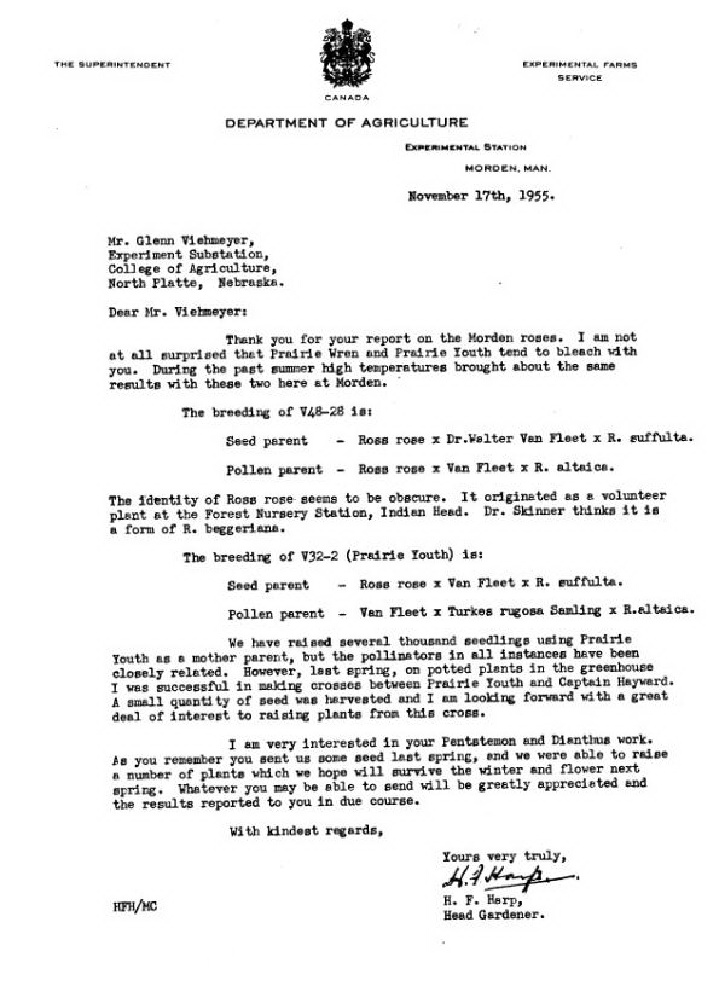
This letter shows that roses were shipped from Morden to North Platte. The RRD infection at Morden was not an
isolated case in 1940. We know from letters and publications that it persisted there through the 1960's. The
Canadian Plant Disease Survey, starting in 1942, began calling "Witches' Broom of Roses" by the name "Rose
Mosaic" which has caused confusion because that name is now used for other rose viruses, as wells as representing a
common virus symptom.
A low rate of seed transmission of RRD would promote its spread. A high rate would alert a nurseryman that something was wrong, but a low rate of transmission would allow infected plants to enter commerce. Mr.Viehmeyer's Morden plants were descended directly from the 'Ross Rambler' so seed transmission must be considered. Tests at WVU were unable to detect seed transmission of RRD on 'R. multiflora' (Amrine, pers com). It is not the only possible method. Seed transmission was not needed to transfer RRD from Morden to North Platte. This could have been accomplished by infection carrying mites landing on a seedling up at Morden before it was shipped out. It is needed for my speculation about 'Ross Rambler' to be the origional source. There were several other roses imported for cold hardy breeding programs, however, that made the same rounds as 'Ross Rambler' and could have been the origional source.
Although RRD was reported first at Morden, the 1956-59 outbreak at North Platte Exp. Sta. is most
significant, because it was from the North Platte Station that RRD began its spread. It had entered the
range of wild rose populations, R. woodsii and gone-wild R. multiflora, large enough to sustain the
disease. From the trial garden at North Platte, Nebraska, which is actually near the South Platte River
(the town of North Platte sits on a peninsula of land just above the confluence of the North and South
Platte Rivers) RRD spread into the wild roses on the South Platte River and then to Wilcox, Nebraska. The timing of subsequent reports of RRD stems from here. It simply moved down and up streambeds, the preferred location of wild roses perhaps with occasional help from birds (transporting infection-carrying mites) and plant pathologists.
Conclusion: RRD may not be native to North America. Only two of the six earliest cases of RRD can not, thus far, be tied back to one imported rose - the 'Ross Rambler'. They are the Lander (Freemont Co.) Wyoming and Carrville (Trinity Co.) California outbreaks, and a plausible explanation of how they could be tied together has been offered. Even without that, I think we have provided a solid case that RRD may not be native to North America. This is of only academic interest to rose growers because Rose Rosette is here to stay. It should be noted that although native status is not a requirement for a biocontrol, RRD's status as native to North America has been a justification for its use as a bioherbicide. This, however, would be important to a rose hybridizer in determining what roses to use in a breeding program attempting to develop ornamental roses with resistence to RRD.
Additional Work to be Done: Although four of the first six early outbreaks of RRD can be tied back to one plant, we have no reports of RRD elsewhere in the world. Retroactively identifying a virus is not possible as there is no material for testing, and no tests exist anyhow. There may be records of aberrant growth and the mite P. fructiphilus (or another mite that fills that niche) in eastern Europe and Asia. Jim Amrine teaches courses in Eriophyid mites to students who come from around the world, so far none have reported any diseases comparable to RRD on roses. The lack of such reports are a weakness to this hypothesis, but if you are not looking for something, chances are, you won't find it. Also, import records from the 30's might still be available to tie the remaining two cases together. Only after the virus (or similar disease) is characterized by virologists can we begin to be sure that no other plants harbor this disease.
***************************************
Part 2 - The Ross Rambler Rose by Percy H. Wright of Saskatoon, Saskatchewan from the 1974
American Rose Annual p.117-119 (Larry's specuilations are in parentheses.)
The 'Ross Rambler' rose is misnamed, since it is not a true rambler all, but merely an extremely vigorous and tall-growing shrub. It is a species brought in by accident from the Himalayan Mountains of north India, but it is perfectly hardy here on the prairies of Canada, having endured 60 degrees below zero without loss of an inch of wood. Such extreme hardiness is remarkable for a rose that blooms continuously from early spring until the heavy frost of autumn, and that is also rapid in growth. By what secret does it combine these 3 valuable features, so rare in combination among roses? I wish I knew.
One lone plant of the Ross Rambler was found growing in a bed of pine seedlings at the
Dominion Forestry Nursery, Indian Head, Saskatchewan, during the time when Mr. Norman Ross
was superintendent. The seed had been imported from India, of what species of pine I do not know. One rose seed had apparently become mixed in with the pine seed at the time the latter was collected.
When Mr. Ross noticed the seedling rose, he had it transplanted to a spot beside the superintendent's
residence, and there it grew to the prodigious height of 24 feet. Mr. Ross sent me a photograph of the
plant showing it up above the second-story windows, so I know for a certainty that the reported height is no fiction. However, when suckers of the original plant were detached and sent to other places for trial, no one else ever got it to grow higher than 12 feet, which was the height it attained in my
nursery near Moose Range. The difference in height has never been explained, and apparently no
theories about it have come forward. (Note: I have a theory - aberrant hyper-growth is a common
symptom of RRD infected roses as mentioned elsewhere in this book. This plant may have had RRD, but could live with it, while the suckers taken from it and given to others only carried RRD and would occasionally become symptomatic). (We are now growing a Ross Rambler, so time will tell.)
The botanical characteristics of the plant are very like those of Rosa laxa alba, which is a native of the adjacent area of Turkestan in central Asia. It has 3 differences from R. laxa alba, however, and one would have a hard time deciding, even if one were a trained taxonomist, which should be regarded as the species and which as the subspecies. R. laxa alba has 9 leaflets per leaf, rather than 7, rarely produces any flowers in the fall, and attains a height of only 8 or 9 feet. Of these differences, the most surprising is the absence of the gene for ever blooming, or rather, perhaps, its presence in the 'Ross Rambler'. Both roses have single flowers of medium size and pure white. Both sucker freely, and the 'Ross Rambler', at least, comes readily from root cuttings. (Note: this is also common for RRD infected roses). Are there further subspecies in the same general area of Asia and, if so, do they have equally interesting variations?
As far as I know, only one attempt has ever been made to use the 'Ross Rambler' rose in a breeding
project, and this was by Mr. William Godfrey who in the '30s and '40s was active as a rose breeder at
the Dominion Experimental Farm, Morden, Manitoba. (Note: Morden was the first reported site of
"Witches' Broom of Roses" (Conners 1941)). He crossed it with the climber 'Dr. W. Van Fleet', a
triploid. The latter must have thrown at least one pollen cell normal to a tetraploid, for Mr. Godfrey was able to carry on the line of breeding. The proportion of genes of the 'Ross Rambler' in his subsequent roses, however, was very small.
I myself once grew a considerable number of open-pollinated seedlings of the 'Ross Rambler'. Because I did not have space to plant out so many, I gave them to Mr. Walter Schowalter, then of Rumsey, Alberta. He grew them to flowering, and sent me a description of the various seedlings. It was easy to conclude from his descriptions that the genes of all the rose varieties growing in the vicinity of the 'Ross Ramble'r plant at the time had their influence on the hybrids. We are safe, therefore, in concluding that the 'Ross Rambler' is willing to accept the pollen of many roses that are not at all closely related to it.
I consider it strange that no further attempts to use the 'Ross Rambler' have been made since that time, for obviously this exotic species or subspecies is of great promise as a parent of new hardy or
semi-hardy roses. It has been completely free of blackspot, mildew, and rose rust for me ever since I
received my first sucker plant about 1935. I, too, am one of those who inexplicably overlooked the rare opportunity its genes almost certainly provided.
Its most important contribution to the roses of the future will probably be stature, for a 12-ft. rose plant, even though it shows none of the features of a climber or rambler, but is rather a dwarf tree, should be valuable for the origination of hardy ever-blooming pillar roses. I assume that any rose variety which produces a large proportion of its flowers at such a height that you have to crane your neck and look upward to see them would be accepted as a "climber" in the broad sense.
I know of no other very promising possibility if one were to aim to originate a pillar rose hardy enough for the prairie provinces of Canada. Here in Saskatchewan all true climbers and ramblers are growthy, so that when fall comes their wood is full of sap and there is almost no chance of hardiness except at the base of the plant, if there. They commonly winterkill, even when with a great deal of trouble they are laid recumbent along the ground and covered with soil and snow. Because most of them do not bloom as they grow, but try to make a tall growth before blooming, the consequence of the attempt to enjoy them here is the production of lots of wood year after year, but rarely a flower.
I lost my first plant of the 'Ross Rambler' by the disease commonly known as Witches' Broom.
However, I was able to get a second start in it from Mr. Walter Schowalter and, after I dug out the
original plant, one of the several plants that re-grew from the cut roots turned out to be clean.
(Note: See FAQ's "Can I reuse the soil?"). I intend to cross the 'Ross Rambler' even yet, with some of my hardy shrub roses; but the really promising cross, surely, would be with the Peace rose, or some other high quality Hybrid Tea. End of the article from 1974 American Rose Annual.
******************************
Part 3 - Original Source Material
The original suggestion that RRD might be native to North America is from a letter dated Sept 14, 1959 from Glen Viehmeyer to plant pathologist and rose expert Dr. Cynthia Westcott. Recently (at that time) retired Dr. Thomas, co-author of the 1953 Thomas & Scott paper on Rose Rosette, in a letter to Mr. Viehmeyer suggested RRD, rather than being native to North Platte, could have migrated along stream beds from Lander, site of the 1941-46 outbreak. He almost certainly did not know Viehmeyer had imported roses from Morden. He was skeptical of RRD as "native". Ironically, Epstein & Hill who dismissed Viehmeyer's work as "erroneous" (E&H, 1998), nonetheless embraced his idea of RRD as native when it helped their idea of RRD as a biocontrol.
When Mr. Viehmeyer heard of Dr. Meyer's work in South Africa (Part 4 below), he reasoned it
couldn't be the same disease because he had convinced himself that his witches' broom was a disease of North America. Had he told Dr. Meyer about the eriophyte mites, perhaps Dr Meyer would have been able to document his disease in a similar fashion in South Africa. There are subsequent suggestions that the South African disease was a form of Verticillium wilt. Even in North American, reports of RRD are met with disbelief. The most common assumption is that it is herbicide damage.
It gets more strange - keep reading. From Glenn Viehmeyer's perspective, near enough to Morden to
have visited and seen the same disease there :
"The following rose species or cultivars have been observed by one of us (Viehmeyer) to be
apparently infected with rose rosette either in the rose nursery at North Platte, Nebr,. or in a
nursery at the Morden Experiment Station , Morden, Manitoba, Canada:
R. canina L. (North Platte, Morden)
R. gallica L. (North Platte)
R.soulieana Crep. do.
R. spinosissima altaica (L.) Rehd. do.
R. hugonis Hemsl. do.
Hybrids of R. eglanteria (North Platte, Morden)
Hybrids of R. multiflora do.
Cultivars of hybrid teas, florabundas do.
and grandifloras
Allington et al, 1968:1139.
Not only was Glen Viehmeyer surrounded by acres of sick roses in his cold hardy breeding program, but he also found roses with similar problems along the Platte Rivers. Then he visited Canada and found the same disease. He could not know he was at the epicenter of two local epidemics, it was reasonable to assume RRD was native. In the three or four years since it arrived in North Platte, RRD had spread to just about every rose he could see. When he went along the river, it was there. From his perspective, it had to be native. Where else could it have come from? When we went to the same spot in 2001, it wasn't there - so much for endemic.
Our experience in East Tennessee has been that it can spread rapidly. We went from Harrogate TN to
Anderson County in 2000 (30 or 40 miles) through the Powell Valley. We saw a lot of multiflora along
the highway, but none was sick with RRD. One year later RRD had spread along the entire route.
Mr. Viehmeyer was sharing all of his information about RRD with Mr. Harp up in Morden, but it may
not have been a two way street. Mr. Harp, sitting at Morden may have heard from other growers, but
he didn't mention this destructive rose disease (that seemed to be so at home on prairie roses) in his
book "The Prairie Gardener". Upon his retirement, Mr. Harp apparently destroyed his own breeding
prgram. That is, at least, the impression we get from the quote below.
"During his working years, Mr Harp introduced 'Prairie Maid', 'Prairie Charm', and 'Prairie
Dawn'. No one seems to know for sure whether they were his crosses, so it is possible they
were not. He seemed to be aware of reaping a predecessor's investment because it is
understood that when he retired, he cleaned out the pipeline. Successors would have to
develop their own. On the other hand, he likely hybridized 'Metis' himself, introducing it in
1967. It comes from a completely different breeding line." ( The Rosebank Letter, No. 16,
page 4)
We are growing 'Metis" the only introduction attributed by Modern Roses XI to Mr. Harp, just for its
historic interest.
Mr. Viehmeyer introduced no roses, his entire rose program died a firey death to try to stop the spread of the disease. In North Platte, one of his assistants still remembers the day they burned the rose fields. His legacy remains in the cold hardy Penstemons and Chrysanthemums (Didemas) he developed as well as the arborteum named to honor him.
*******************************
Part 4 - RRD in South Africa?
In the 1950's a virus-like disease of roses was found in South Africa. It seems to have died out,
possibly due to the lack of a host population of wild roses to serve as a reservoir. It was called "Little
Leaf" and below is an Abstract by Dr. M. A. Meyer.
MEYER (M. A.). Virus diseases of Roses in South Africa.-S. Afr. J. agric. &i. 3, 3, pp. 467-471, 1 pl. (7 fig.), 1960.
Various virus symptoms of the mosaic type have been observed in S. Africa on rose vars. (listed). Rose wilt [cf. 38, 523] has so far been recorded only in Pretoria. Another disease causing loss of vigour and premature decline is named little leaf. Instead of the buds developing normally to form single vigorous shoots they become multiple, producing a number of short pale shoots. Little leaf has been observed only in hybrid tea and floribunda vars. and the cause has yet to be determined.
In the 40's - 60's the term "mosaic" was often used as a synonym for any rose virus that showed leaf
color distortions with sharp margins. The name change from "witches broom" to "mosaic" in the
Canadian Plant Disease Survey reflects a similar change in thought; in Canada the mosaic was described as infectious mosaic. If we simply had the abstract above, we would not consider a connection with RRD. We have, however, a letter from Dr. Meyer to Dr. Westcott detailing the symptoms as zinc deficency. It was similar enough to the disease that Glen Viehmeyer described that she forwarded Meyer's letter to Viehmeyer. When Mr. Viehmeyer heard of Dr. Meyer's work in South Africa, he reasoned it couldn't be the same disease because he was convinced that his witches' broom was native to North America. Had he told Dr. Meyer about the eriophyte mites, perhaps Dr Meyer would have been able to document his disease in a similar fashion in South Africa.
We have questioned some growers in South Africa and they tell us that disease in retrospect is thought to have been a mildew although I don't know if mildews are graft transmissible. We've been unable to access records from that time in South Africa.
Top of Page
*****************************
Part 5 - RRD in Czechoslovakia? Or recently in Poland?
From Review of Applies Mycology 1949
KLASTERSKY (I.). A new morphogenic virosis on Roses.-Studia bot. Czechoslov, 10, 1-3, pp. 1-13, 1949.
In 1940 Rosa lucida, R. rugosa, and the Gloire de Mousseuses moss rose growing in the garden of the Botanical Department of the National Museum, Praha- Troja, Czechoslovakia, developed abnormal cowl- or cornet-shaped leaves. In 1942, the rose bushes were transferred to another locality, cowl-shaped leaflets and other irregularities reappeared in R. lucida. Inoculations carried out with crushed cowl-shaped leaflets of this species in 1947 produced cowl-shaped leaflets and irregularities in R. moyesii and R.arvensis. It is concluded that these are no spontaneous teratological phenomena as previously assumed, but that they are by a group of viruses transmitted by an insect vector.
UPDATE (January 2007)
Or Recently in Poland?
Since I wrote the above, I have found papers describing a rose disease in Polish Greenhouses where roses are produced for the cut flower trade. The disease was called both "Rose dieback" and "Rose degeneration" and some of the symptoms resemble symptoms of RRD. Scientists studying the outbreak have isolated a phytoplasma as the causal agent and have replicated the agent. Their more recent papers indicate that they do not believe it is the same disease as RRD. They cited the test described in one of Epstein and Hill's papers where RRD was tested with Streptomycin and the disease was not cured. Asters Yellow is supposed to by cured by applications of Streptomycin.
A selection of their papers:
Kaminska, M., Dziekanowska, D., Wisniewska-Grzeszkiewicz, D., 2001, Molecular Evidence for the Presence of Aster Yellows Related Phytoplasma in Rose Plants, Acta Horticulturae 547: 365-370
Kaminska, M., Dziekanowska, D., Rudzinska-Langwald, A.2001, Detection of Phytoplasma Infection in Rose, with Degeneration Symptoms. Journal Phytopathology 149(1):3-10. .
Kaminska, M., Sliwa, H., Malinowski, T., Skrzypczak, C. 2003, The association of asters yellow phytoplasma with Rose Dieback Disease in Poland. J Phytopathology. 151(7-8): 469-476.
Kaminska, M., Sliwa, H, 2004, First report of phytoplasma belonging to apple proliferation group in roses in Poland. Plant Disease. 19(2): 323-329.
Top of Page
******************************
Part 6 - Did Redoute' Paint a Picture of RRD 160 Years Ago?
There are many problems dealing with references that are not tied to extant roses. The illustration
below, is of a rose interpreted by Redoute.
There are two things in this illustration that draw attention: first, the distortion of the leaves (some
editions refer to this as the rose with celery leaves). Discussion in my version of Redoute says," This
plant is valued for its unusual foliage, which has crisped, curled edges, very much like those of celery, parsley or gooseberries. It is propagated by layering...(which) is necessary because the variety will not always breed true from seed.....Apparently it prefers a little benign neglect; too much care, often causes the most flourishing specimens to perish."
Second is the color of the leaves. I grow several centifolias (and this rose is also called Rosa centifolia bipinnata) and none show reddish undersides of new growth leaflets. Yet leaflets on this rose, especially at left are distinctly pink verging on red. These are colors I've seen on many epinastic leaves on roses with RRD. This was not a healthy rose, whether infected by phytoplasma or virus, and it has something commonly caused epinastic distortion of the discolored leaves.
As Redoute's Plates were hand colored, some guide would have existed to specify that color. No colorist would have verged from the expected colors without having a strong reason, directions from the master, most probably.
A project for someone with lots of leisure would be to visit many of the early collections of Redoute prints and compare the colors of the leaves in this picture (as well as the colors of the other roses...just for fun). (I doubt that grant money is available for this endeavor from the Iowa Beef Producers, however, if it is, my application will be in the mail.)
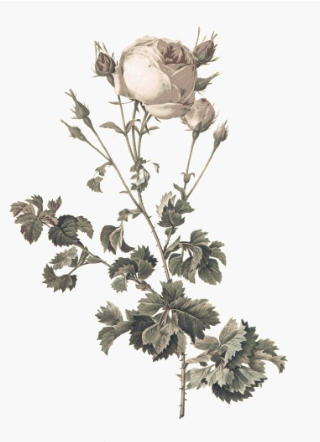
Fig. 2 The Celery-leaved Rose ( R. centifolia bipinnata)
Top of Page
***************************
References Cited:
Conners, I.L., 1941, Twentieth Annual Report of the Canadian Plant Disease Survey 1940, Dominion of
Canada,Department of Agriculture, Science Service, Division of Botny and Plant Pathology, p.98.
Conners, I.L., 1942, Twenty-first Annual Report of the Canadian Plant Disease Survey 1941, Dominion of
Canada,Department of Agriculture, Science Service, Division of Botny and Plant Pathology, p.98.
Conners, I.L., 1943, Twenty-second Annual Report of the Canadian Plant Disease Survey 1942, Dominion of
Canada,Department of Agriculture, Science Service, Division of Botny and Plant Pathology, p.98.
Conners, I.L., 1944, Twenty-third Annual Report of the Canadian Plant Disease Survey 1943, Dominion of
Canada,Department of Agriculture, Science Service, Division of Botny and Plant Pathology, p.98.
Epstein, A.H., 1992, Rose Rosette Disease:An All-American Malady of Rose. American Rose (2):24-25.
Epstein, A.H. and Hill. J.H. 1994.Rose rosette disease:Historical aspects and current status., in Proceedings
of the International Symposium Rose Rosette and other Eriophyid Mite-Transmitted Plant DIsease Agents of
Uncertain Etiology May 19-24,1994, A.H. Epstein and J.H. Hill, eds.47-51.
Epstein, A.H., and Hill, J.H., 1994. Characteristics and Control of Rose Rosette Disease.American
Rose Annual: 23.
Epstein, A.H., and Hill, J.T., 1995, The Biology of Rose Rosette Disease: A Mite-associated Disease of
Uncertain Aetiology. J. Phytopathology !43:353-360.
Epstein, A.H., Hill, J.H., and Nutter, F.W., 1997. Augmentation of rose rosette disease for biocontrol of
multiflora rose (Rosa multiflora). Weed Science 45:172-178.
Epstein, A.H., and Hill, J.H., 1998. Progress report Rose Rosette Disease. American Rose: 16-17.
Epstein, A.H., and Hill, J.H., 1999,Status of Rose Rosette Disease as a Biological Control for Multiflora Rose.
Plant Disease 83(2): 92-101.
Little, T.M., 1942. American Rose Annual, The Distribution of North American Rose Species, p.37.
McFarland, J.H., 1935. American Rose Annual, The Ross Rambler and Other Hardy Roses, p.115.
Preston, I., 1940. American Rose Annual, Central Canadian Rose-Breeding p.91.
Preston, I., 1946. American Rose Annual, Update on Central Canadian Rose-Breeding.
Thomas, E.A., Scott, C.E., 1953. Rosette of Rose. Phytopathology 43: 218-219.
Viehmeyer, G. 1962. A “new” disease of Roses. American Rose Annual:98-101.
Wright, P. H. 1938. American Rose Annual, The "Arcticness" of Various Roses, p.71.
Wright, P. H. 1972. American Rose Annual, The "Arcticness" of Various Roses, p.117.
Top of Page
Next Page
